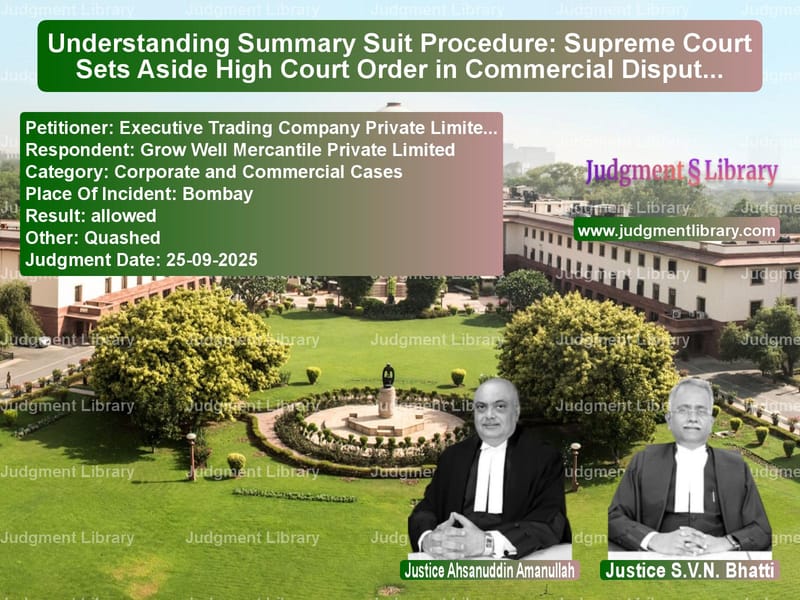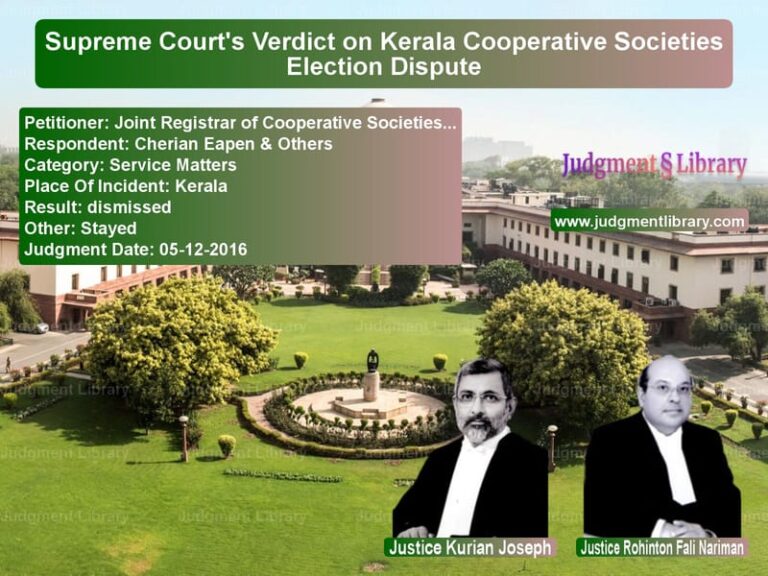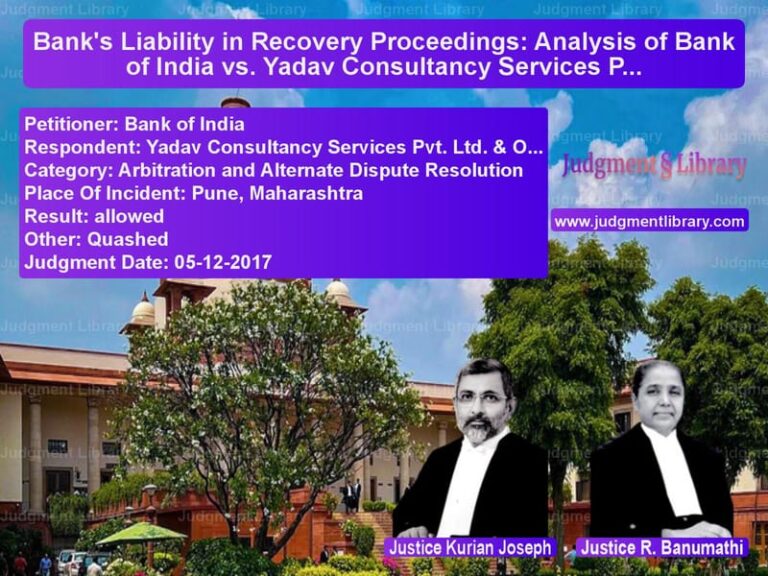Understanding Summary Suit Procedure: Supreme Court Sets Aside High Court Order in Commercial Dispute
The Supreme Court of India recently delivered a significant judgment that underscores the importance of strictly following procedural law in commercial summary suits. The case, Executive Trading Company Private Limited versus Grow Well Mercantile Private Limited, revolves around a procedural misstep by the High Court that, according to the Supreme Court, went to the very root of the matter. This ruling serves as a crucial reminder of the distinct legal pathway prescribed for summary suits under Order XXXVII of the Code of Civil Procedure, 1908 (CPC).
The dispute began when Executive Trading Company (the appellant) filed a commercial summary suit before the Bombay High Court to recover a significant sum of money, alleging an admitted liability of over Rs. 2.15 crore from Grow Well Mercantile (the respondent). The appellant filed the suit under Order XXXVII of the CPC, a special provision designed for swift adjudication of money claims where the defendant is not perceived to have a substantial defence.
The Core Procedural Dispute
The heart of the matter before the Supreme Court was a specific order passed by the High Court on December 5, 2023. The impugned order directed: “1. Let the reply to the Summons for Judgment be filed by 20th December, 2023 with a copy to the other side. Rejoinder, if any, be filed by 9th January, 2024 with a copy to the other side. 2. List on 9th January, 2024.”
The appellant, Executive Trading Company, challenged this order, arguing that it was procedurally incorrect and unsustainable. Their primary contention was that in a summary suit, a defendant cannot simply file a ‘reply’ to the summons for judgment. The correct procedure, they argued, mandates that the defendant must first file an application seeking leave to defend the suit.
The Petitioner’s Arguments
Advocate for the petitioner, Mr. Debesh Panda, argued that the High Court’s order bypassed the fundamental requirements of Order XXXVII. He pointed out the chronological sequence of events: the suit was filed, summons were served, the defendant entered appearance, and the plaintiff then filed a ‘summons for judgment’. At this stage, the defendant’s only recourse, if it wished to contest the claim, was to apply for leave to defend by disclosing a genuine and substantial defence. Instead of doing this, the respondent had filed other applications, including one for dismissing the suit for non-compliance with pre-litigation mediation, which was allowed, leading to a mediation process that ultimately failed.
The petitioner’s counsel emphasized that the step ordered by the High Court—allowing a direct reply to the summons for judgment—was a procedural error. He stressed that “the requirement in terms of sub-Rule (5) of Rule 3 of Order XXXVII of the CPC is to file an application seeking leave to file the defence.” The court must first decide on this application for leave, and only if leave is granted can the defendant proceed to file its defence. Allowing a defence to come on record without this crucial filter, the petitioner argued, blurs the critical distinction between a regular suit and a summary suit.
The Respondent’s Counter-Arguments
Appearing for the respondent, Grow Well Mercantile, Advocate Mr. Sanampreet Singh offered a different perspective. He contended that the respondent had filed an application for condoning the delay in applying for leave to defend, and this application was still pending before the High Court. He argued that even if an application was filed under a wrong provision, it should not automatically lead to a decree in the plaintiff’s favour. He further stated that the delay alleged by the plaintiff was factually incorrect and that it was always open for the defendant to convince the court to either grant leave or condone the delay. His argument essentially was that technicalities should not override the substantive opportunity to present a defence.
The Supreme Court’s Analysis and Key Arguments
The Supreme Court, comprising Justices Ahsanuddin Amanullah and S.V.N. Bhatti, delved into the precise procedure outlined in Order XXXVII, Rule 3 of the CPC. The Court meticulously outlined the sequence of steps:
First, the plaintiff serves the summons and plaint. The defendant must enter an appearance within ten days. The plaintiff then serves a ‘summons for judgment’. Crucially, upon receiving this summons, the defendant has ten days to apply for leave to defend by filing an affidavit that discloses what it believes is a genuine and substantial defence. The court then examines this application. Leave to defend should be granted unless the defence is frivolous or vexatious. If leave is not applied for, or is refused, the plaintiff becomes entitled to an immediate judgment.
The Court noted that the respondent had not followed this path. Instead of applying for leave to defend after the summons for judgment was served, it took other steps, and much later, filed an application for condonation of delay in applying for leave. The High Court, meanwhile, had simply allowed a ‘reply’ to be filed.
The Supreme Court found this procedural deviation unacceptable. The Court made a powerful observation, stating: “without much deliberation, we are of the view that the order impugned needs to be interfered with in as much as if a reply or defence is allowed to come on record in a summary suit without the Leave of the Court then the distinction sought to be maintained between a Suit normally instituted and Summary Suit under Order XXXVII of the CPC stands effaced. The procedural deviation goes to the root of the matter.”
This argument is the cornerstone of the judgment. The Court emphasized that the entire purpose of a summary suit procedure is to provide a swift remedy in clear-cut cases. Allowing a defendant to file a defence without first obtaining the court’s leave to do so effectively converts the summary suit into an ordinary suit, defeating its very objective. The procedure is not a mere technicality; it is the fundamental framework that gives summary suits their unique and expedited character.
The Final Ruling and Its Implications
Consequently, the Supreme Court allowed the appeal and set aside the High Court’s order dated December 5, 2023. However, the Court was careful to clarify that its ruling was purely on the procedural aspect. It explicitly stated that “the setting aside of the order impugned shall not be understood as foreclosing the options available to the Defendant in the Judgment Summons already issued, or the observations made in the present order shall not prejudice the case of either party.”
This means that the respondent, Grow Well Mercantile, is not barred from pursuing its pending application for condonation of delay in filing for leave to defend. The Supreme Court has merely reset the process, directing the parties to follow the correct procedural path as envisaged under Rule 3 of Order XXXVII of the CPC. The merits of the defendant’s defence or the plaintiff’s claim were not examined at this stage.
This judgment reinforces the principle that procedure is the handmaid of justice. While courts often lean towards allowing a hearing on the merits, certain procedural rules are sacrosanct because they uphold the structure and efficiency of the legal system. For commercial litigants, this ruling is a vital lesson: the summary suit procedure is a specialized mechanism with strict timelines and steps, and any deviation can have significant consequences, as seen in this case. It ensures that the expeditious nature of summary suits is preserved, benefiting creditors with legitimate and undisputed claims while still providing a fair, albeit filtered, opportunity for debtors to present a substantial defence.
Petitioner Name: Executive Trading Company Private Limited.Respondent Name: Grow Well Mercantile Private Limited.Judgment By: Justice Ahsanuddin Amanullah, Justice S.V.N. Bhatti.Place Of Incident: Bombay.Judgment Date: 25-09-2025.Result: allowed.
Don’t miss out on the full details! Download the complete judgment in PDF format below and gain valuable insights instantly!
Download Judgment: executive-trading-co-vs-grow-well-mercantile-supreme-court-of-india-judgment-dated-25-09-2025.pdf
Directly Download Judgment: Directly download this Judgment
See all petitions in Debt Recovery
See all petitions in Contract Disputes
See all petitions in Corporate Compliance
See all petitions in Company Law
See all petitions in Judgment by Ahsanuddin Amanullah
See all petitions in Judgment by S.V.N. Bhatti
See all petitions in allowed
See all petitions in Quashed
See all petitions in supreme court of India judgments September 2025
See all petitions in 2025 judgments
See all posts in Corporate and Commercial Cases Category
See all allowed petitions in Corporate and Commercial Cases Category
See all Dismissed petitions in Corporate and Commercial Cases Category
See all partially allowed petitions in Corporate and Commercial Cases Category







